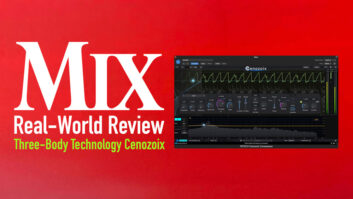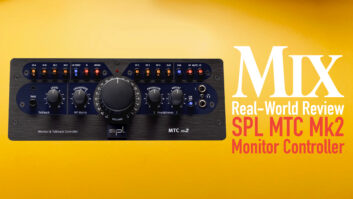
| MIX VERDICT: BETTERMAKER VALVE STEREO PASSIVE EQUALIZER |
| THE TAKEAWAY: “The main reason I am drawn to the Bettermaker Valve EQ is its smooth tube/ transformer sound controlled by a modern plug-in interface.” |
| COMPANY: XXX • www.bettermaker.com PRICE: $2,999 PROS: • Classic passive EQ design that sounds great. CONS: • The software interface and instructions could be better. |
New York, NY (August 20, 2024)—Usually, solid-state processors are the progeny of their vintage, tube-based parents. However, the Bettermaker Valve Stereo Passive Equalizer is similar in form and function to its predecessor, the solid-state Bettermaker Stereo Passive Equalizer introduced in 2022. Both are stereo, two-band, passive equalizers with selectable frequency and variable bandwidth. Both versions work as standalone equalizers and/or can be controlled via a native plug-in supported by AU, VST or AAX hosts.
Parameter changes are bi-directional. In the plug-in, mousing a control knob, switch or a node in the spectrum analyzer is immediately visible on the unit’s front panel; likewise, changes made using the VSPE’s front-panel controls are indicated in the software. The VSPE interfaces with your computer using a USB cable—but no audio passes through it. The VSPE itself must be connected like any other analog stereo EQ, in the signal path with the plug-in inserted on the same audio.
A comparison of the listed specifications of Bettermaker’s Stereo Passive Equalizer with the new Valve Stereo Passive Equalizer reveals that they are nearly identical, with the same performance, frequency choices, boost/cut ranges, and a Hi-Boost Curve that changes the Q for the high-frequency equalizer. I like that there are no rotary switches to replace; small, lighted pushbuttons step through frequency choices and are good for finding the sweet spot.
The differences between the SPE and VSPE start to emerge with dual-triode tubes (valves) used as output amplifiers. The Valve version has a Heat feature, which switches in another amplifier to drive the valve output amplifier and transformers harder. To compensate for the level increase, a 6 dB pad is inserted, and the unit’s output impedance changes from 1,200 ohms down to 30 ohms. By using relays, switching Heat in/out is seamless.
The VSPE has an exacting, semi-parametric high-pass and low-pass filter set; it runs like a conventional EQ plug-in—only in the software. These have slopes of either 12 dB/octave or 24 dB/octave, with the HPF ranges from 20 Hz to 500 Hz and LPF ranges from 1 kHz to 20 kHz. Setting this filter is my first step when developing an EQ for any source.

DAYS OF FUTURE PAST
Like the Pultec EQP-1A Tube Program EQ, you can boost one frequency and, at the same time, cut at the same frequency. This contorts the resultant resposne curve as shown on the spectrum analyzer. The VSPE does the same trick but also adds high-frequency choices of 20 and 28 kHz to the standard Pultec frequencies of 3, 4, 5, 6, 8, 10, 12 and 16 kHz. The low-frequency section covers 20, 30, 60 and 100 Hz.
The main reason I am drawn to the Bettermaker Valve EQ is its smooth tube/ transformer sound controlled by a modern plug-in interface. It is a time-proven, vintage design that benefits greatly from modern software with its precision control, preset memories and resizable GUI. For fast A/B comparisons, there is the handy snapshot window above the main screen for storing up to 32 snapshots—or, copies of presets. Changing snapshots, as with all VSPE controls, is automatable.
There is a switchable Auto Audition solo for hearing the range of frequencies affected by a selected EQ band. There are also stereo input meters but no output meters. The spectrum analyzer shows the audio superimposed with color-coded EQ and filter curves. There is a drop-down menu for the operational preferences of the Analyzer that includes zoom, resolution, window size and more. These settings are saved with the presets.
Also saved with the preset is a unique feature called Control Resolution. There are 101 steps for Lo Boost, Lo Cut, and Hi Boost Curve, and 34 steps for Hi Cut. In Quantize mode, this is streamed down to 17 steps. Changing from low to high resolution does not affect alreadywritten automation. This mode is disabled in standalone operation.
The Connection Menu is used to connect and switch plug-in control of multiple VSPE units for Dolby Atmos mixing or for use on different tracks in your mix. I didn’t test this, but you would connect a USB cable from each VSPE to a hub, then select the desired unit from a window in the upper-right corner.
Controlling hardware gear via a connected plug-in or standalone software is a new trend— look for more popular outboard gear starting to be offered with and without front-panel controls. Case in point: My Eventide H9000R is a blank-panel version of the H9000 Ultra Harmonizer and controlled by the standalone software and/or the Emote plug-in.
INSIDE STORY, WITH SOME HEAT
Like with the black-panel SPE, behind the VSPE’s blue front panel is a single, large circuit board that holds all the switches, LEDs and the five mounted controllers. VSPE is powered by a 12-volt wall-wart with plug adapters for anywhere in the world.
Inside on the main board are a DC-to-DC converter, two matched inductors for the equalizers, associated ICs for the USB GUI interfacing, and the circuitry for driving the red LED rings around the controls. Low-noise, Burr-Brown op amps are employed, along with a set of (Mil-Spec), high-reliability relays for the hardwire bypass and for engaging Heat.
A separate board has the tube output amps, with two (new-old stock) Soviet-made pencil vacuum tubes. These are carefully matched and tested twin-triodes that are soldered in place; they drive the two large Bettermaker TT-1 output transformers (one for each channel), which are made in Poland. The tubes and internal fuse would have to be replaced by the factory, if ever required.
SSL Pure Drive Octo – A Mix Real-World Review
Stick-on paper labels are used to identify the Heat and/or Reset buttons. The Gain/Reset button, when held down for two seconds, resets the entire VSPE. Tapping the same button puts the unit into a “secondary layer,” with Heat mode on and the Gain/Reset button (annoyingly) flashing red. The 5 kHz LED in the Hi-Cut band is also lit red, with the Hi-Cut control now becoming the Gain control used to set final output level and for overdriving the tubes and transformers.
All the other controls on the unit go dark and inoperative while in Heat mode. The equalizer controls are adjustable in the plug-in, or tap on the Gain/Reset button again and you’re back to the “first layer” for normal operation. For fast A/ Bs of Heat on/off, simply tap the 5 kHz button while in Heat mode. In my opinion, all Heat operation and control should be done in the software, seeing as a dedicated Gain control and Heat on/off button are already there.
VSPE IN THE STUDIO
I connected the VSPE to a stereo pair of balanced I/O channels from my DAW, placed in the chain before my Manley NuMu Compressor Limiter for a mastering session.
I had a reggae song with a very loud kick drum and bass guitar—super-big with a lot of subsonic level. The total energy was good until the bass player started to play a busier eighthnote pattern in the chorus. Then the whole bottom end became a muddy mess.
I set up two snapshots: a verse EQ with just a Hi boost at 6 kHz, and a second for correcting the booming low frequency on the choruses. I automated changing snapshots in Pro Tools.
For the corrective snapshot, I first set the digital filter to 24 dB/octave at 49 Hz. Next, Lo Boost was set to 2.8 at 100 Hz, with Lo Cut at 1.0. The Hi Boost Curve was very broad at 6 kHz and Hi Boost at 3.3, with no Hi Cut. The digital filters are set by mousing over their knobs to read their current value in a pop-up window; the filter’s action is displayed in red curves. You can grab these curves with your mouse and move them to your liking.
The Gain control was at 1.6, but that depends on how much level you want to drive the compressor. It was easy to get -10 LUFs with this all-tube chain—if you’re interested. Because of its high precision and Class-A operation, the VSPE makes a great two-band mastering/touchup-style program EQ.
In dual-channel mode, the VSPE becomes two single-channel EQs selectable in the software; both channels are unlinked, so you can dial up completely different settings on each. I like dual mono mode for vocals, kick drums, bass synths, acoustic guitars and more. I tried dual-mono mode followed by an API 529 VCA-based stereo compressor/limiter for two clean electric guitar tracks and loved it. The Heat feature fattened them up nicely giving them a certain color in the track.







